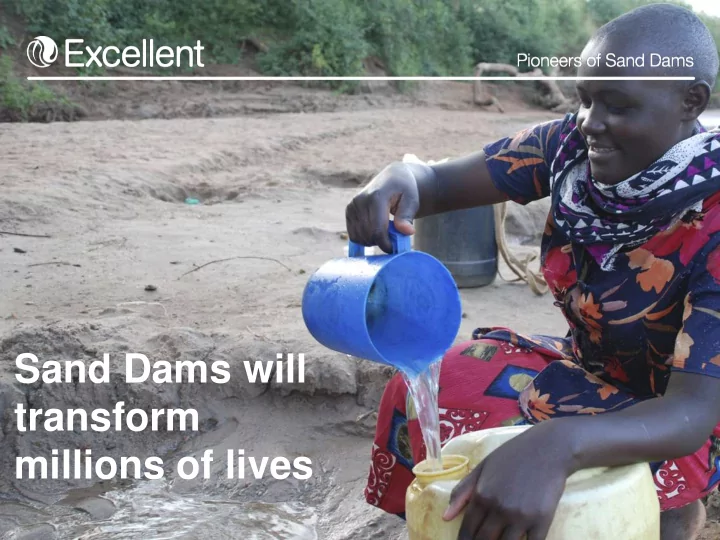

Sand Dams will transform millions of lives
Sand dams will transform millions of lives • Sand Dams are effectively horizontal boreholes with minimal O&M costs • Sand Dams are the world’s lowest cost method of capturing rainwater in dry rural areas. • We support Sand Dams as locally requested, built and owned resources – providing a year round supply of water Sand dams work. We believe they will transform millions of lives. 2
Conservation leading to development We support farmers to reduce extreme poverty through soil and water conservation. soil & water water food incomes conservation supply production & health Trees Terraces Sand Dams Trees Inter-cropping Sand Dams Pipelines Bee-keeping Crop diversification Trees Water Tanks Milk production Fruit & vegetables Seed Banks community self-help groups working together 3
What is a sand dam? • A sand dam is a reinforced concrete wall built in a seasonal riverbed to capture and store water beneath sand, both filtering and protecting it. • A sand dam holds 2-10 million litres of water and is the world’s lowest -cost rainwater harvesting solution. find a rock base in dry riverbed build a reinforced concrete wall 4
How does a sand dam work? Seasonal rains quickly fill the dam with water and soil. The soil is made up of silt and sand. The heavier sand sinks behind the dam, whilst the lighter silt washes downstream. 5
How does a sand dam work? The sand accumulates until the dam is completely full of sand up to the spillway. Water is stored within the sand making up 25-40% of the total volume. This means that 2-10 million litres of water are captured - depending on the sand particle size and the size of the dam. 6
Getting water from sand dams There are three main ways to abstract water from sand dams. The community decides on the most appropriate option for them. 1. Scoop holes 2. Pipe filtration 3. Shallow wells • Evaporation is reduced to a minimum • The sand also filters the water clean and protects it from parasite carriers such as mosquitoes and snails. • This reduces considerably the risk of the world’s two biggest killers of children under five: malaria and diarrhoea. 7
Sand dams improve water supplies • A sand dam creates a local, reliable, clean water supply for up to 1,000 people for life. • A sand dam stores 2-20 million litres of water each season and recharges naturally. • Held below the sand, water is prevented from evaporating. • A sand dam provides enough water for people to drink, water their animals, and irrigate their crops. A sand dam provides 1 person with clean water for life, for just £10. (Based on the typical sand dam in Kenya costing £10,000 and providing water for 1,000 people: Source Excellent Development). 8
Sand dams enable food production £1 invested in agriculture and rural development generates a fourfold return Source: Adolf Kloke-Lesch, BMZ • Sand dams save farmers 2-12 hours every day. • Time saved can now be invested in activities to improve harvests. • Having water nearby in the sand dams makes growing fruit and vegetables possible. • Farmers can irrigate crops even during the dry season. 9
Sand dams benefit health & incomes • Mosquitoes cannot breed – reducing the incidence of malaria. • Snails carrying the bilharzias virus cannot survive – dramatically reducing the risk of diarrhoea. • Diets improve as farmers have time to improve harvests and diversify crops. • Incomes improve as people have time to spend on livelihoods. The UN estimates that every £1 invested in water supply in developing countries delivers £6 in increased incomes, health and education benefits. Source: Asia Waterwatch 2005 10
Strategic partnership to Pioneer Sand Dams Makueni County, Eastern Province, Kenya Brentford, West London, UK
Recommend
More recommend